The Sierra Designs Flex Capacitor is a top-loading backpack with a unique top lid and compression straps on the sides and front that let you modify the pack’s volume or strap bulky gear to the outside. This is complemented by a stiff but lightweight frame that makes it possible to haul heavy loads, far exceeding those that can be carried by similarly sized ultralight or internal frame backpacks. Updated in 2023, the Flex Capacitor Backpack has several new features that make it better than ever. If you’re looking for one pack for year-round backpacking, the Flex Capacitor is hard to beat.
RELATED: 10 Best Ultralight Backpacks (with Frames)
Specs at a Glance (40-60L)
- Gender: Unisex
- Mfg Pack Weight: 3 lbs 2 oz (size M/L)
- Actual Tested Pack Weight: 2 lbs 15.5 oz (size M/L)
- Load lifters: Yes
- Pockets: 9 + main
- Torso lengths (2): S/M (16″-19″) and M/L (18″-21″)
- Hip belt lengths (2): NA
- Max recommended load: 50 pounds
- Bear canister compatibility: BearVault BV500 and all smaller sizes fit horizontally
- Fabric: Body is 100D Nylon-Poly ripstop, Base is a 420D Nylon Oxford
Originally designed by Andrew Skurka, Sierra Designs made a few significant changes to the Flex Capacitor in this latest update.
- There are two large stretch mesh pockets on the sides of the pocket situated above the side mesh water bottle pockets. They really enhance the usability of the backpack.
- The side compression straps can be (optionally) buried in fabric channels rather than running over the new large stretch mesh pockets on the sides of the pack.
- The number of volume-reduction straps was reduced from four to two.
- The internal mesh hydration sleeve in the previous version has been replaced by a solid hydration sleeve that can be used as a summit backpack for short hikes.
- While the hipbelt is still technically interchangeable, it appears that Sierra Designs has stopped offering hipbelts in different lengths.
- The larger 60-75L model of the Flex Capacitor has been replaced by one with 60-80L of capacity.

Internal Storage and Organization
The Flex Capacitor has a large main compartment, two side water bottle pockets, and two large stretch mesh pockets above them. There are two large, solid-faced pockets on the hip belt and two stretch mesh pockets on the shoulder straps. The main compartment has a removable hydration pocket (1.7 oz) with a single hydration port behind the neck for a hydration hose (along with a hang loop if you want to suspend a hydration bladder without using the hydration pocket). The hydration pocket can be transformed into a summit pack by repurposing the pack’s compression straps as shoulder straps but it has so little volume, you’d probably never use it that way.
A top lid crowns the main compartment with two burley zippers and flips up to provide access to the inside of the pack. It’s much faster to use than a roll-top closure and far less annoying if you have to do it a lot. The top lid contains a shallow top pocket with a key fob, sized to hold thin objects like a Smartphone or snack bars. When flipped open, the top of the pack is large enough to swallow a large Bearvault BV500 bear canister horizontally, so no worries there. All of the zippers on the top lid are protected from rain and dust by solid fabric flaps.

The two side water bottle pockets are reachable while wearing the backpack and it’s easy to pull bottles out or put them back. The side pockets are sized for one 1L Nalgene bottle, although they stretch enough to also accommodate tent poles or a Tenkara rod that’s lashed under the compression straps and rests in the side bottle pocket.
The Flex Capacitor hip belt has two large hip belt pockets which are big enough to store all of your daily snacks, water purification drops, and electronics. Both pockets are hard-faced with fabric and quite durable, even when hiking off-trail through scrub, thorns, and brush.
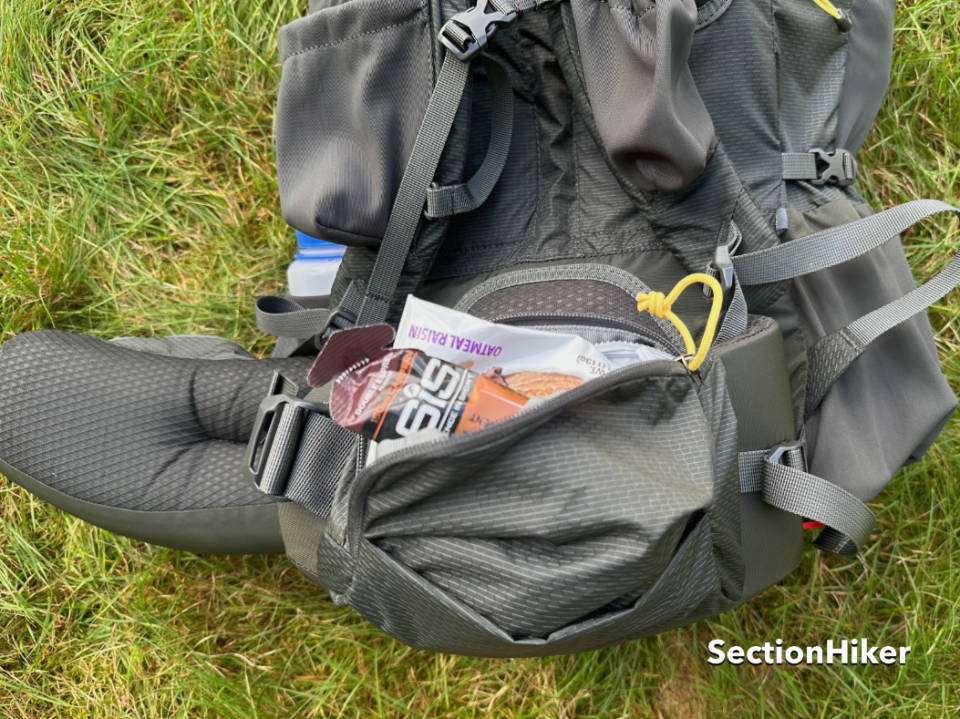
External storage was quite limited on the original version of the Flex Capacitor, particularly for wet items like rain gear, a wet tent, or a wet water filter. This new model has two large stretch pockets on the sides above the water bottle pockets that provide abundant external open storage and compensate for the lack of the front stretch pocket that is found today on most lightweight backpacking packs. These new pockets are large enough to hold lots of gear and clothing and provide the ability to segregate your gear by function or “wetness” in a way that is even better than a single front stretch mesh pocket. They’re a really great enhancement.

The placement of these new mesh pockets required a refactoring of two of the pack’s compression straps, which are now buried in fabric channels along the top and bottom of the mesh. At first, I thought this would reduce the pack’s ability to carry snowshoes along the pack sides, but on further inspection, you can pull the compression straps out of the fabric channels to use them for this purpose. That’s a relief because the 50lb load-carrying capacity of the Flex Capacitor makes it an excellent option for winter backpacking and expedition travel.
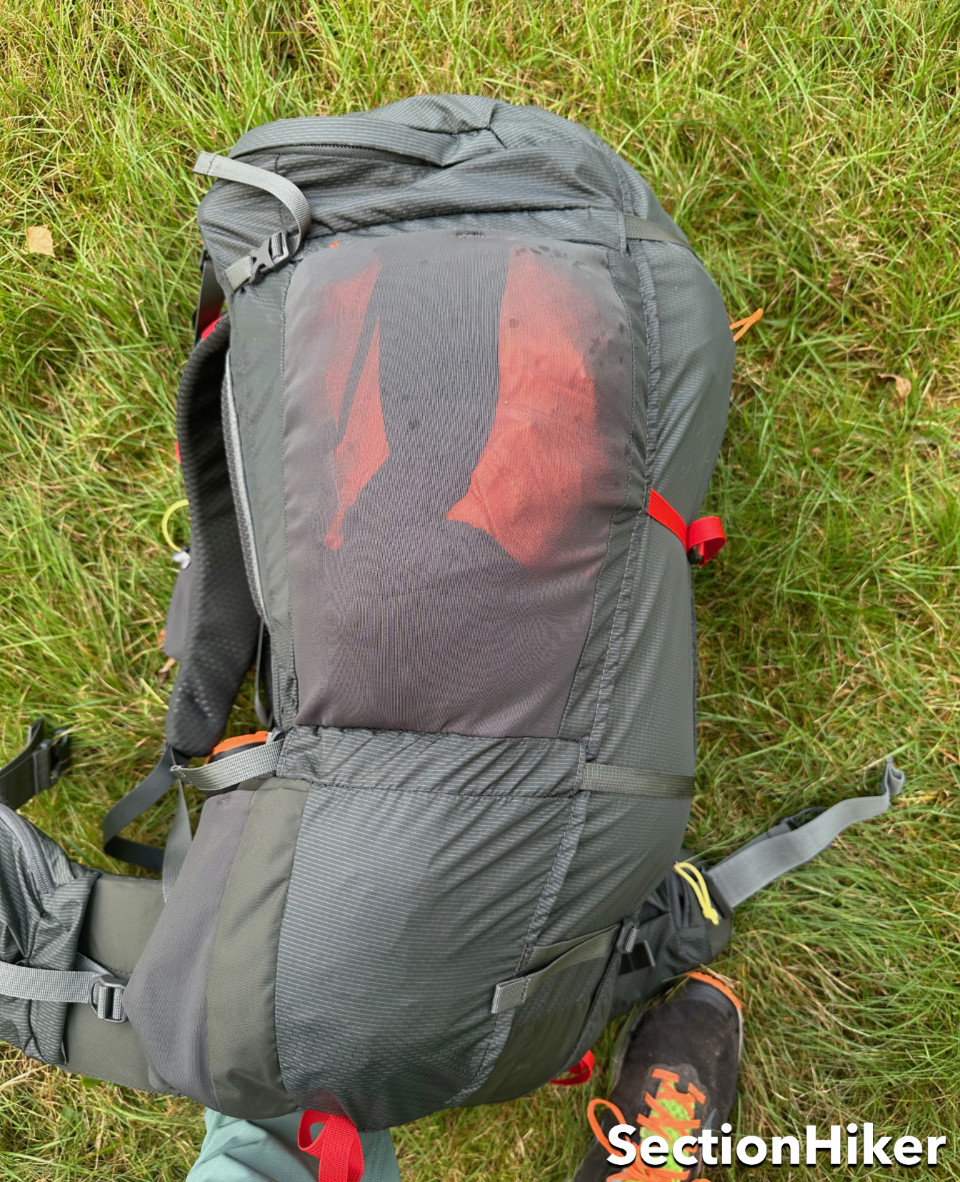
External Attachment and Compression System
The Flex Capacitor has numerous external straps including two tiers of compression straps, two volume-adjustment straps, and two ice ax loops. Despite this, the straps never feel like they’re overwhelming the pack and they don’t “get in the way.” The compression straps run continuously across the sides and back of the pack and can be used to compress your load or attach gear to the outside of the pack. They’re long enough and spaced far enough apart so that you can attach snowshoes, skis, packraft paddles, a sleeping pad, secure ice ax shafts, or an avalanche shovel to the pack when you have to haul heavy gear. The compression straps also close with buckles which makes them much easier to use in winter, particularly when wearing gloves.

The volume of the main compartment is controlled by two compression straps and two volume reduction straps. When loosened, they release the gusseted back of the Flex Capacitor and increase the diameter of the pack’s main compartment, expanding the volume of the pack from 40L to 60L, or whatever fraction you want in between. This is particularly useful if you want one backpack that can be used for multi-day backpacking or long day hikes and not two.
There are also two ice ax loops on the bottom of the Flex capacitor, but no shaft holders…you just secure the shafts using the other webbing straps on the back of the pack or thread your own using cord and some cord locks.
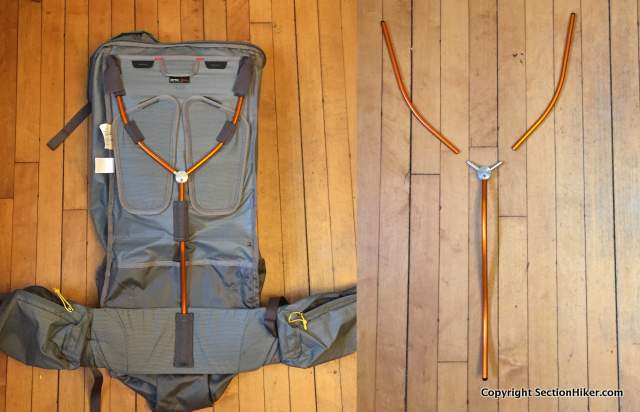
Backpack Frame and Suspension
The Flex Capacitor has a Y-shaped, aluminum frame stay that slots into the pack’s hip belt, providing an excellent load transfer to the hips when carrying heavy loads, up to 50 pounds. It’s really a remarkable frame, given how lightweight and simple it is. The secret sauce that makes it so supportive is the tension in which it’s held in place inside the backpack. While removable, it takes some elbow grease to remove and replace the aluminum stay.
However, the back of the Flex capacitor is very stiff and less form-fitting than other lightweight packs. While there is mesh-covered padding on the back, it’s quite firm and it takes a while to get used to the pressure it exerts on the shoulder blades and lumbar area of your back. While any discomfort fades into the background eventually, it’s a very different sensation than most multi-day backpacks.
The Y-shaped frame and padding work together to provide a large air channel behind your back through which air can pass, in order to reduce perspiration buildup. Sweat dripping down your back and into your underwear is a key cause of chafing, which is why good back ventilation is important.

The Flex Capacitor’s shoulder straps are simple J-straps without a lot of attachment points. Both the right and left shoulder straps have a stretch pocket that’s large enough for a small smartphone or snack bars While both straps have an elastic band for managing a hydration hose, there aren’t any daisy chains, plastic rings, or good anchor points for attaching other accessory pockets or electronic navigation tools. If you want to keep those tools handy, you’re best off storing them in the pack’s large hip belt pockets.
The hipbelt is heavily padded and quite firm, providing excellent load transfer in conjunction with the pack’s rigid frame. I didn’t experience any hip belt slippage at all, even with heavier loads. The hipbelt is tightened using push-forward straps, now standard on many backpacks. It closes with a beefy center buckle which is much easier to use in winter with gloves. Hip control straps are also provided to pull the pack bag closer to your hips.
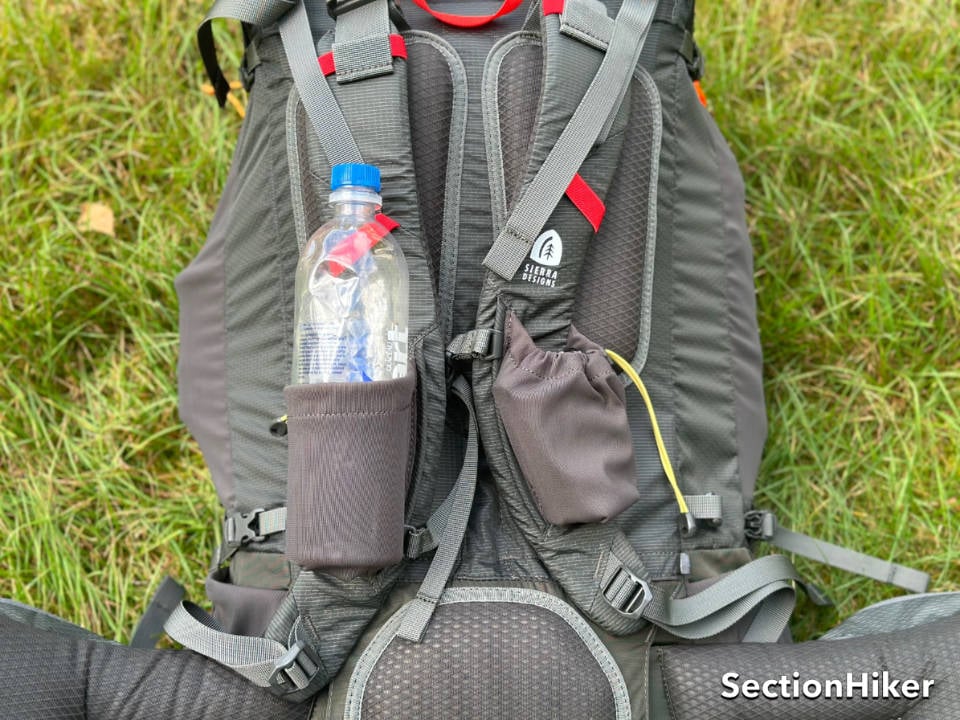
Comparable Lightweight Backpacks
| Make / Model | Weight | Fabric |
|---|---|---|
| Zpacks Arc Haul 60L | 20.9 oz / 593g | Ultra 200 |
| Hyperlite Mountain Gear Southwest 55 | 34.9 oz / 989g | Dyneema DCF |
| Granite Gear Crown 3 60L | 32.6 oz / 1040g | Robic Nylon |
| Osprey Exos Pro 55 | 34.6 oz / 981g | UHMWPE Nylon Ripstop |
| ULA Circuit 68L | 37.3 oz / 1038g | Robic Nylon |
| Gossamer Gear Mariposa 60L | 34.2 oz / 968g | Robic Nylon |
| REI Flash 55L | 45 oz / 1276g | Robic Nylon |
| Gregory Focal 58 | 41.3 oz / 1171g | Robic Nylon |
| SWD UL Long Haul 50 | 30.2 oz / 856g | Ultra 200 |
| Durston Kakwa 55 | 31 oz / 880g | Ultra 200 |
Recommendation
The Sierra Designs Flex Capacitor Backpack is a lightweight multi-day backpack with a rigid, but lightweight frame that is capable of handling heavy loads of 50 pounds or more. That alone makes it a unique offering among lightweight backpacks weighing 3 pounds or less. But the novelty of this backpack doesn’t stop there. It can expand from 40L to 60L of capacity if you need to carry a lot of gear or food, including a bear canister. It’s also easy to attach a ton of gear to the exterior of the pack, which is durable enough that you can take it off-trail without worrying about it being ripped to shreds by thorns and aggressive vegetation. The biggest question you need to ask yourself if you’re considering the Flex Capacitor is whether you need the extra load carrying capabilities it provides. If you need to “go heavy,” then the Flex Capacitor is one of the best lightweight packs under three pounds that can get the job done.
Disclosure: Sierra Designs donated a backpack for review.
Compare 2 Prices
-
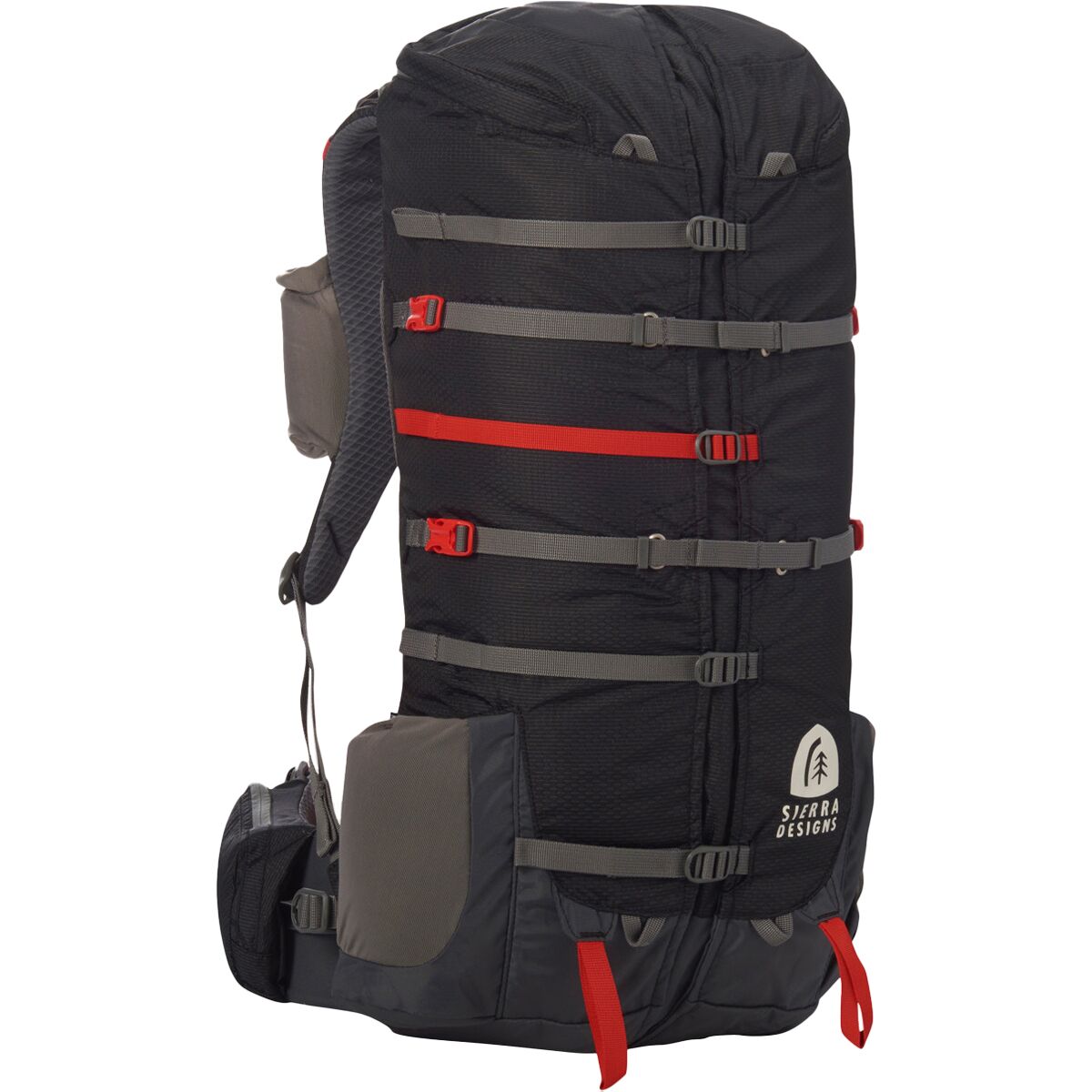
 Backcountry.com
Backcountry.com$179.95$116.97View -

 Amazon US$129.97View
Amazon US$129.97ViewAmazon.com Price: $129.97 (as of 04/24/2024 16:33 GMT-0400) Details
Product prices and availability are accurate as of the date/time indicated and are subject to change. Any price and availability information displayed on Amazon.com at the time of purchase will apply to the purchase of this product.
-
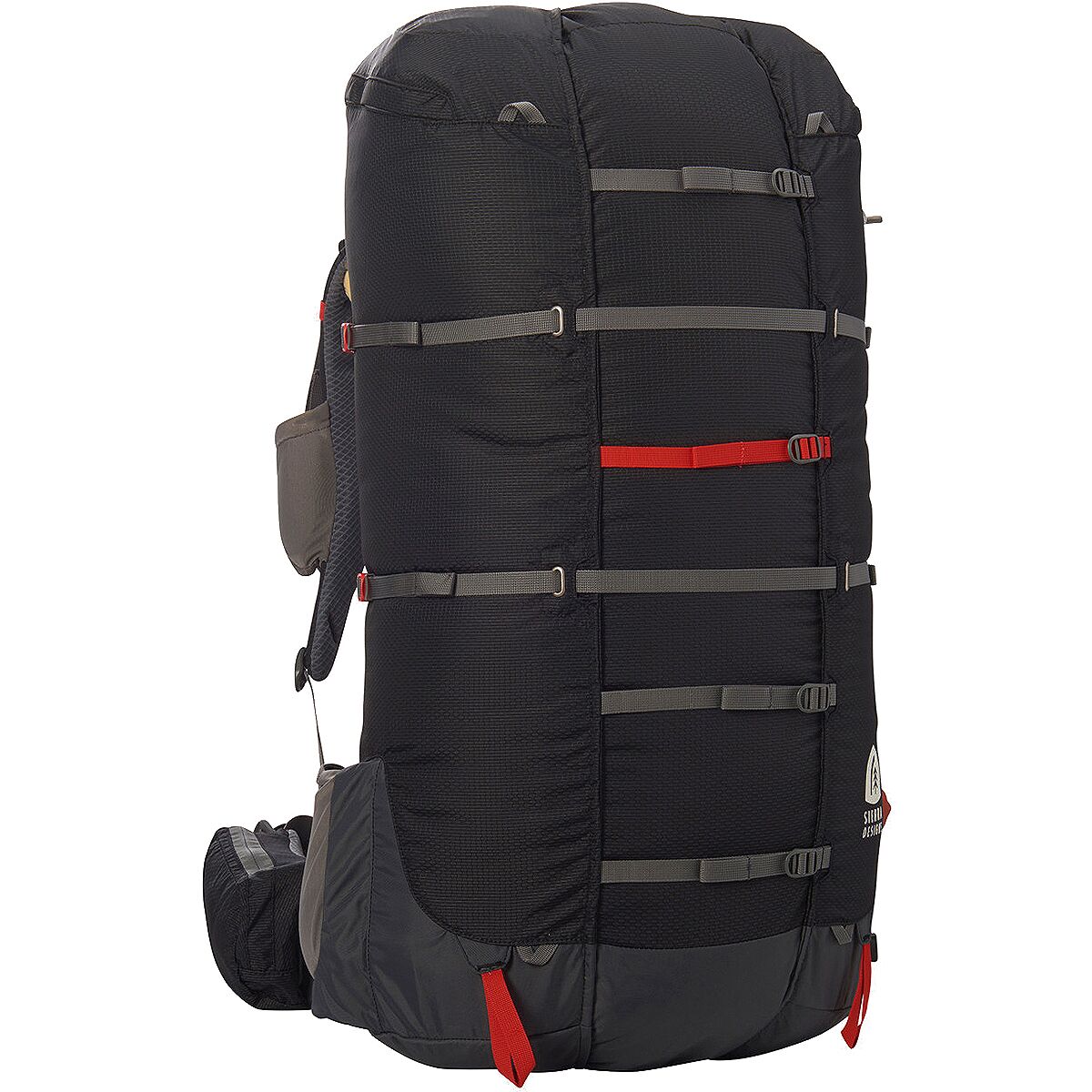
 Backcountry.com
Backcountry.com$199.95$129.97View
 SectionHiker.com Backpacking Gear Reviews and FAQs
SectionHiker.com Backpacking Gear Reviews and FAQs 
i’ll second the back padding being an acquired taste, especially the lumbar pad. I hated it at first but now find it quite comfortable. My biggest gripe is how small the top pocket was, too bad they didn’t fix that, but the mesh pockets are a welcome addition.
Literally, my only complaint is exactly this—wasted space. Insteas of a rectangular storage pocket, it is a butterfly shaped pocket that limits of storage capacity.
Those new mesh pockets are really fantastic. They really make the pack a contender.
I’ve always liked the design of this pack, and the changes over the years have been improvements. Sadly, it doesn’t come in my size. I am a shade over 21 inches torso length. I tried one once and it was way too short. I think if you are 20 inches or over you should try it on before committing.
Thanks for posting Philip, I purchased one of the older versions. The upper side pockets are a great addition, I wish more companies did this.
Unfortunately that lumbar pad was too much for me and very uncomfortable. Soreness and redness the day after an 8 mile hike. Other than that the pack was great and the variable capacity is awesome.
I have the 60-80 model which I got for the added hip belt padding and transfer compared to my Hyperlite Southwest 70 which I love but is a bit under padded for when it is loaded to max. I agree with most of your review except that I don’t think this pack is really convenient for external attachments of anything that doesn’t fir in the main bag or external pockets There are no daisy chain loops on the front or top and the compression straps don’t seem well positioned for that, in part because of how they run into the pack sleeves. I guess the philosophy here is that most everything should fit inside or in the pockets. Anything thin like poles could easily be put in the side pockets and straps. But snow shoes, or a zero chair, not so much.
Hmm. I attached snowshoes to the sides of my 40-60 quite easily. You just have to pull the side compression straps out of their channels and crank them down. Alternatively you could just stack them on the front center between the channels. I find the Southwest 55 pretty difficult to use that way without the addition of lots of elastic cordage. If you’re in NH, I’d be happy to see and discuss your issues first hand.
Not my experience. I just returned from a 6 day trip that required externally attaching an REI Flash 15, a pair of water shoes and a wag bag setup. Easy to attach and balance the weight.
I have used the new 60-80 liter pack on 3 long trips thus far, and absolutely love it. Holds a Bear Vault 500 without a problem. It is also very comfortable.
Notice that the 60-80 liter size is going for $199. A great price for a pack with all these features and a proven design. Very refreshing.
Yes, that is one of the big attractions of this backpack. Comfort carrying a bear can, large external pockets, low weight, a lot of adjustability, all for a nominal price. Even a car key hook. I’m definitely a fan. Phil’s review definitely hit the mark on this pack. For shorter trips, I’m really happy with my new Mystery Ranch Coulee 50; also a very comfortable pack. On a recent trip it easily accomodated our 2-person tent, a Bear Vault 475, clothes, group cooking gear, and a puffy for the sub-30 degree temps we had in the eastern Sierras in early October. This works especially well when the hydration bladder is placed in the exterior side pocket.
I must be “bitten.” My 2019 Baltoro is still good as new. But it’s “heavy,” has small (unusable) hip pockets, and no shoulder strap pockets. I’ve been looking to buy something as strong, but lighter. It seemed from this review that the 2023 Flex Capacitor was near perfect for me. So I was prepared to spend $200 to save 2 lbs. (!) But while looking at Sierra Designs’ website, I tripped across a business decision of theirs. Namely, that they – as a company – contribute part of their sales to a certain social cause. An unnatural cause, which, in my Book, is evil, to which I cannot – and will not – contribute. I don’t understand why companies chose to alienate part of their customer base. (REI, CNOC, Bud Lite, Disney, Target, et al.) Especially those in small niche markets like ours. (A Lifetime Warranty isn’t any good if you go out of business.) It’s not a good business model and not what customers are paying for. (Think sport events nowadays where the NFL preaches to you.) But that’s their choice. My choice is to not give them my money. Hopefully there will be a review here in the future of another backpack that I can buy in good conscience.
Just buy it on amazon. They don’t have a social conscious.
Frankly, they don’t want money from people like you. Helping people is good no matter what cause it is under, and hatred gets us nowhere.
Isn’t it ironic that companies who show mercy and compassion and forgiveness of sinners are met with hatred and aggression by hypocrites who spew their venom in the name of the very person who spent His life teaching those exact principals. Didn’t that same man call on His TRUE followers to live their lives in his image? Talk about a swing and a miss!
Hi Philip, which do you prefer between the Flex Capacitor and the Granite Gear Blaze 60? Currently trying to decide between these two packs and I see you’ve reviewed them both in recent months.
I like the Blaze 60 better. It has an adjustable length torso and adjustable length hip belt. For winter hiking, I also prefer a pack with a top lid, but the Blaze also has a roll top which you can use if you remove the top lid.
I got this pack to do the SHR where I would be carrying enough food to get from Roads End to Reds Meadow (big mistake). During my trial run ruck, the frame snapped. It was difficult to replace and I may have inserted the replacement incorrectly but the bottom stem poked through the pack. I considered it dangerous in case of a fall because it protruded past my tailbone so I aborted the trip after Frozen Lake Pass. Also the hip belt rubbed the skin off my coccyx.
I use a Hyperlite now and have had no issues.